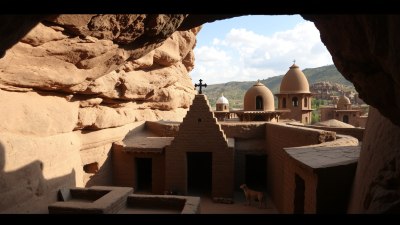Silence Between the Walls in Lalibela, Ethiopia
Explore the serene beauty and historical significance of Lalibela, Ethiopia, known for its stunning rock-hewn churches and sacred silence.

Lalibela, a town in the northern part of Ethiopia, is famous for its extraordinary rock-hewn churches, an architectural marvel of the medieval period. These churches were created in the 12th and 13th centuries and hold deep historical and cultural significance for the Ethiopian Orthodox Church. Every year, thousands of pilgrims and tourists visit this UNESCO World Heritage site, drawn not only by its stunning construction but also by the profound silence that permeates its sacred spaces.
The silence in Lalibela is not merely the absence of noise; it is a palpable presence that envelops visitors, inviting a contemplation of spirituality and history. This silence echoes between the walls of the churches, creating an atmosphere that heightens the experience of those who walk through these ancient structures. The churches, carved into volcanic rock, were meant to be a symbol of heaven on earth, and the serene environment reinforces this intention.
The Historical Background of Lalibela
The origins of Lalibela trace back to King Lalibela, who aspired to establish a New Jerusalem. After the failure of the crusades, Lalibela sought to create a Christian pilgrimage destination that could rival Jerusalem's significance. This vision was realized through the impressive engineering and architectural design of eleven monolithic churches, which continue to be an essential center of worship.
Each of the churches in Lalibela is unique, representing different biblical themes and stories. Some of the most notable include Bet Giyorgis, which is dedicated to Saint George, and Bet Medhane Alem, often referred to as the largest of the churches. The architectural brilliance lies not only in their construction but in the way they integrate with the natural landscape, maintaining a profound relationship with the surrounding environment.
The Spiritual Significance of Silence
Silence has always been a significant aspect of spiritual practices across various cultures and religions, and in Lalibela, it holds particular importance. For many pilgrims, the journey to Lalibela is one of deep personal reflection and devotion. The quietness found within the church walls allows individuals to engage in their contemplative practices without distractions, facilitating a deeper connection to their faith.
In the Ethiopian Orthodox tradition, silence is often associated with prayer and contemplation. The churches of Lalibela serve as sacred spaces where one can disconnect from the noise of the outside world and immerse themselves in the tranquility of the divine. This spiritual silence resonates with the teachings of prayer, meditation, and the pursuit of inner peace, encouraging visitors to embark on their journeys of self-discovery.
Architecture and Design of the Rock-Hewn Churches
The design of Lalibela's churches is remarkable, showcasing a unique blend of Christian symbolism and Ethiopian cultural identity. The churches were hewn from solid rock, with no traditional construction materials used, emphasizing the dedication and perseverance of the artisans who created them. The precision of the carvings is striking, with intricate details found on facades, doorways, and interiors that tell stories of faith and heritage.
Visitors to Lalibela are often astounded by the feat of engineering displayed in structures that appear to defy gravity. The churches are not merely functional; they are artistic representations of spiritual beliefs. Each church is designed to evoke a sense of wonder and reverence, enhanced by the surrounding landscape, which adds to the overall spiritual journey.
The Role of Pilgrimage in Lalibela
For many Ethiopians and Christians around the world, the pilgrimage to Lalibela is a lifelong dream. The journey to this sacred site is often undertaken with a deep sense of purpose and devotion. Pilgrims come to celebrate important religious festivals, such as Timkat, which commemorates the baptism of Christ. During this time, the churches come alive with colorful processions, chants, and prayers, blending the sacred silence with joyful celebration.
Throughout the year, the steady stream of pilgrims reinforces the living tradition of faith that Lalibela represents. The camaraderie of the faithful, united by their shared beliefs, enriches the experience of silence, as each individual contributes to a collective atmosphere of reverence and respect.
The Natural Setting of Lalibela
Aside from its architectural wonders, Lalibela is also known for its stunning natural landscapes. Nestled in the Ethiopian Highlands, the area is characterized by dramatic cliffs, rolling hills, and vibrant flora. The geography provides not just a backdrop for the churches but also an integral part of the experience that enhances the sense of peace and silence.
The contrast between the rich historical significance and the tranquil natural environment is what makes Lalibela feel sacred. Visitors often take time to reflect in silence while surrounded by breathtaking vistas, allowing them to absorb the beauty and serenity of the environment. This connection with nature amplifies the spiritual experience, creating a harmonious blend of earth and heaven.
Preservation Efforts and Challenges
Community involvement is essential in these efforts, as the locals understand the profound impact that Lalibela has on their identity and heritage. Education programs aimed at increasing awareness about cultural preservation and sustainability are crucial in fostering a sense of responsibility among the younger generation. The goal is to create a symbiosis between tourism and conservation to ensure that the silent sanctity of Lalibela endures.
A Call to Experience the Silence
Visiting Lalibela offers an opportunity not just to witness architectural beauty but to experience the silence that resides between its walls. It is a journey that transcends mere tourism; it is an exploration of faith, history, and the profound connection between spirituality and the natural world. As one wanders through the rock-hewn sanctuaries, the silence speaks volumes, urging visitors to reflect, pray, and find solace amidst the noise of modern life.
As travelers embark on this sacred pilgrimage, they are invited to engage with the essence of Lalibela, embracing the silence that invites inner peace and spiritual fulfillment. Whether one seeks to deepen their faith, learn about history, or simply enjoy the beauty of Ethiopia, Lalibela stands ready to offer a unique experience that resonates long after leaving its hallowed grounds.











